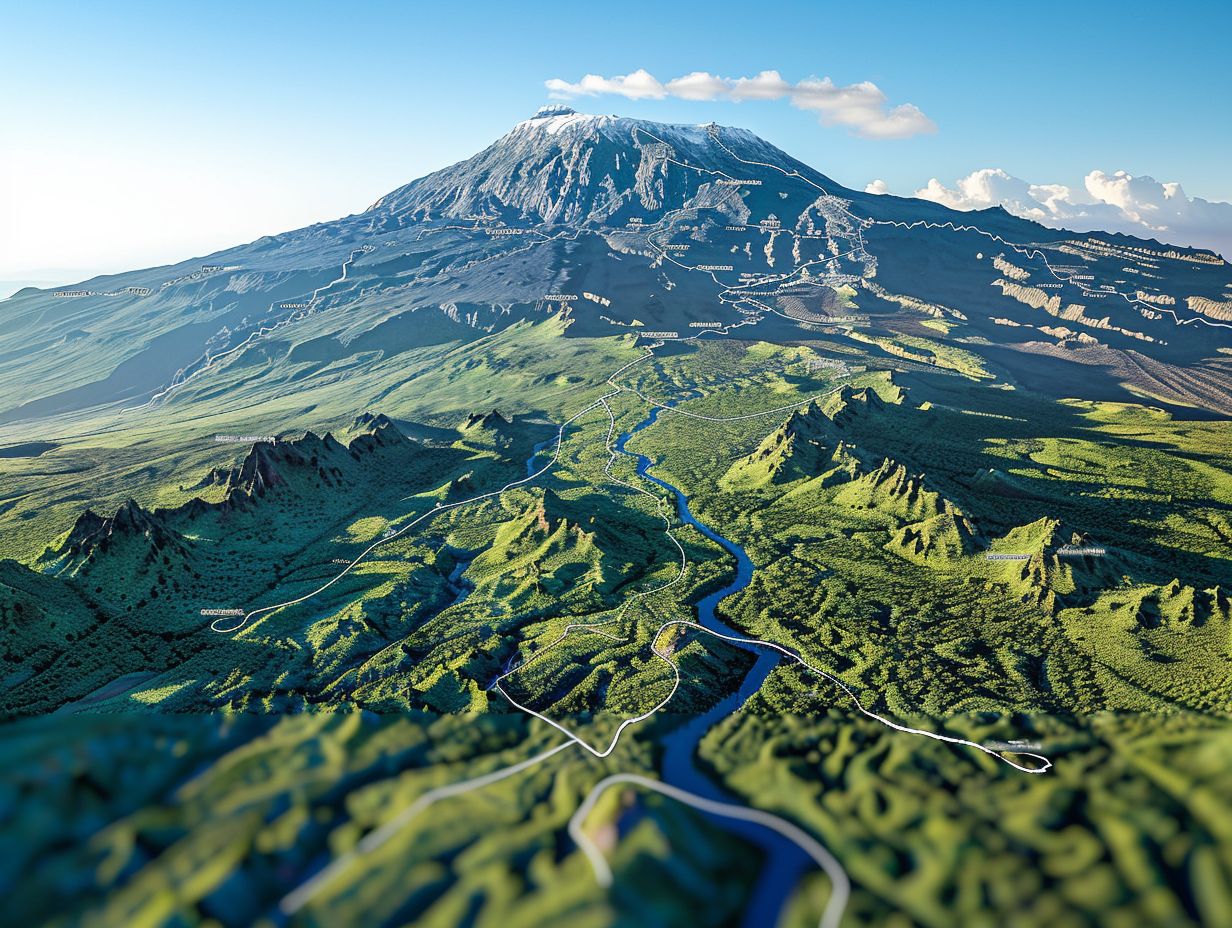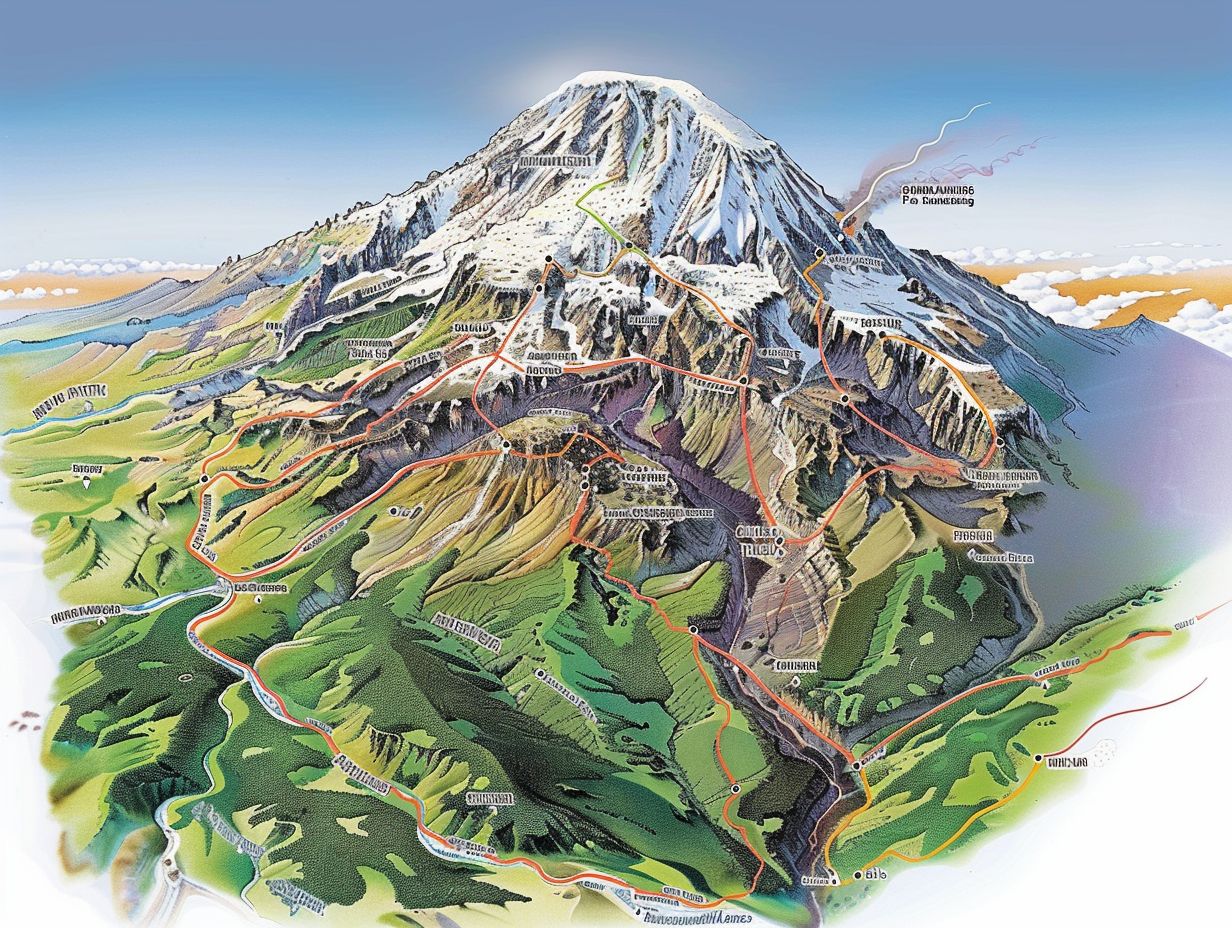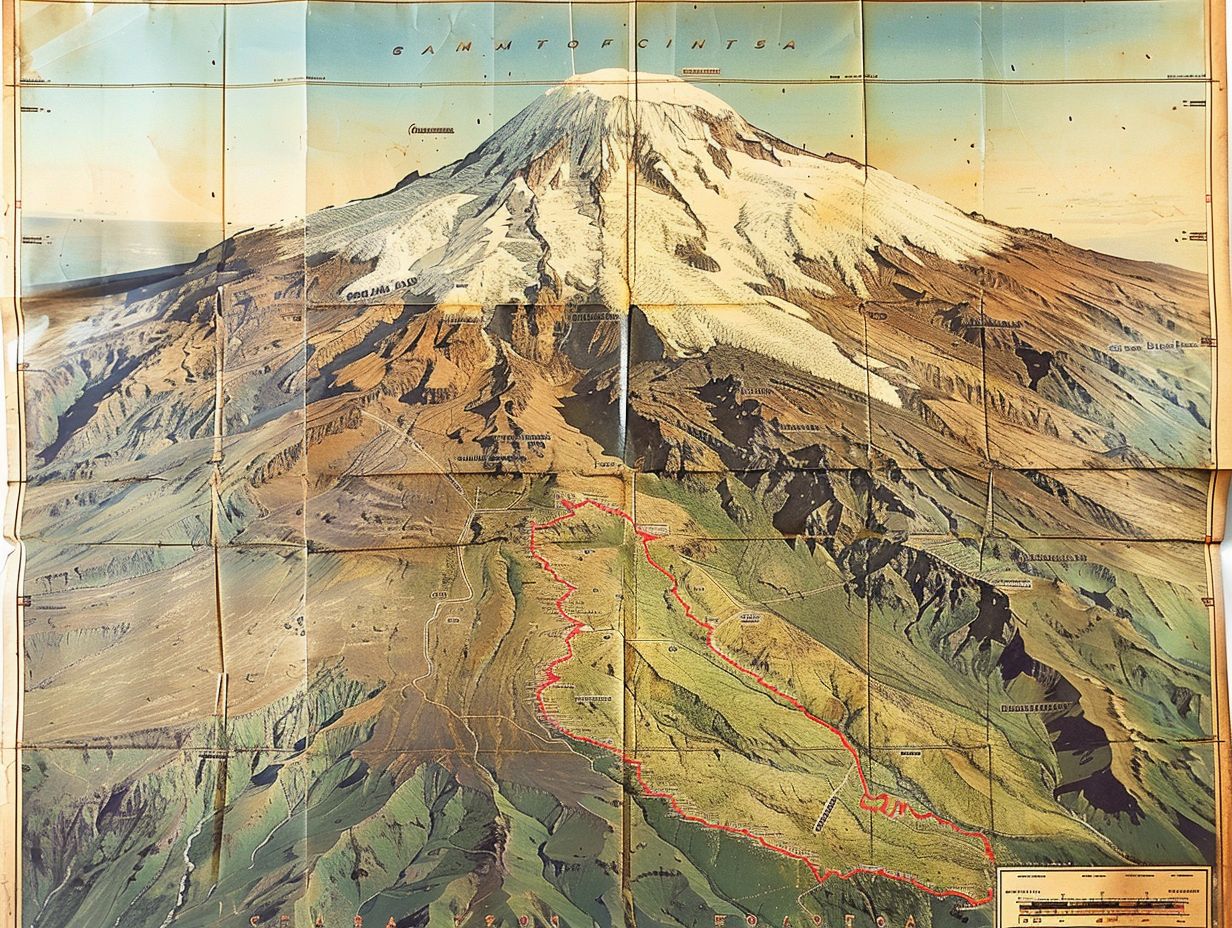
Kilimanjaro Routes Overview
Mount Kilimanjaro, the highest peak in Africa, offers a variety of routes for climbers of all experience levels.
Popular routes like the Machame and Marangu, as well as lesser-traveled paths like the Lemosho and Rongai, each present unique challenges and rewards.
This article will explore the differences between the routes in terms of difficulty, scenery, altitude changes, and duration of the climb.
Whether you’re a beginner looking for the best route to start with or an experienced climber seeking a new challenge, factors like fitness level, budget, and time constraints should be considered when choosing the perfect route for your Kilimanjaro adventure.
Key Takeaways:

- There are multiple routes to climb Mount Kilimanjaro, each with its own unique features and challenges.
- The most popular routes are Marangu, Machame, Lemosho, and Rongai, while the less traveled routes include Umbwe, Shira, and Northern Circuit.
- When choosing a route, consider factors such as difficulty level, scenery and terrain, altitude changes, duration, fitness level, budget, and time constraints.
How Many Routes are there to Climb Mount Kilimanjaro?
There are several routes available for climbers to conquer Mount Kilimanjaro, each offering a unique trekking experience with varying terrains, landscapes, and challenges. Each route presents an opportunity to summit the majestic peak and enjoy the breathtaking views along the way.
One of the most popular routes is the Marangu route, also known as the ‘Coca-Cola route,’ favored for its gradual ascent and hut accommodations. In contrast, the Machame route, often referred to as the ‘Whiskey route,’ offers a more challenging trek with stunning scenery, including the Shira Plateau and Barranco Wall. The Lemosho route is renowned for its scenic beauty and a longer, more gradual ascent, providing ample time for acclimatization.
For those seeking a quieter experience, the Rongai route on the northern face of the mountain offers a less traveled path with unique perspectives of Kilimanjaro. The Umbwe route, known for its steep inclines and shorter duration, is preferred by experienced climbers looking for a more direct ascent. The Northern Circuit route, the longest option, encircles Kilimanjaro, providing panoramic views and excellent acclimatization opportunities.
-
What are the Most Popular Routes?
The most popular routes on Mount Kilimanjaro include the Lemosho route, Machame route, Marangu route, and Rongai route, each known for its unique attractions such as diverse landscapes, comfortable huts for overnight stays, and well-maintained trails.
The Lemosho route stands out for its stunning scenery, traversing through lush rainforests to alpine meadows, offering ample opportunities for acclimatization along the way. This route is considered one of the most beautiful but also one of the longer options.
The Machame route, also known as the ‘Whiskey Route,’ is favored for its breathtaking views of Uhuru Peak. It provides a more challenging climb compared to Marangu, with varied terrain including steep ascents and descents.
The Marangu route, often referred to as the ‘Coca-Cola Route,’ is known for its comfortable hut accommodations, providing a more leisurely ascent but with fewer acclimatization opportunities.
Meanwhile, the Rongai route, starting from the north, offers a more remote and less crowded experience, with a gradual ascent through diverse landscapes, making it an appealing choice for those seeking a quieter climb.
-
What are the Less Traveled Routes?
For those seeking a more off-the-beaten-path experience, the Shira route, Northern Circuit, and Umbwe route offer less traveled paths up Mount Kilimanjaro, showcasing untouched scenery, challenging trekking opportunities, and a chance to explore the mountain’s hidden gems.
Among these routes, the Shira route stands out for its unique approach from the west, providing stunning views of the Shira Plateau and the western side of Kilimanjaro. Adventurous climbers are drawn to the rugged terrain and sparse crowds that characterize this path.
On the other hand, the Northern Circuit offers a longer journey around the northern slopes, allowing for better acclimatization and a diverse range of ecosystems to traverse.
Meanwhile, the Umbwe route challenges hikers with its steep ascent, making it one of the toughest but most rewarding options for those seeking a true test of endurance.
What are the Differences between the Routes?

The routes on Mount Kilimanjaro vary significantly in terms of difficulty, scenery, terrain, altitude changes, and duration of the climb. Each route presents its challenges and rewards, catering to climbers with different skill levels and preferences.
For instance, the Marangu route, also known as the ‘Coca-Cola route,’ is considered one of the easier paths due to its gradual slopes but brings less varied scenery compared to other routes.
In contrast, the Machame route, known as the ‘Whiskey route,’ offers a more challenging ascent with steeper trails and stunning landscapes of the rainforest, alpine deserts, and glaciers. Meanwhile, the Lemosho route boasts a longer duration, allowing for better acclimatization and breathtaking panoramas. Each route on Kilimanjaro truly offers a unique adventure for climbers seeking diverse experiences.
-
Difficulty Level:
The difficulty levels of the Kilimanjaro routes are influenced by factors such as the Western Breach, challenging terrains, and icy glaciers that climbers and hikers must navigate. These features add an element of adventure and risk to the climbing experience.
For climbers seeking a thrilling ascent, the Western Breach stands out as one of the most demanding sections of Mount Kilimanjaro, requiring technical skills and stamina. The steep, rocky path challenges even the most experienced adventurers, with loose scree making every step precarious. The ever-changing weather conditions can escalate the level of difficulty, exposing climbers to extreme cold and high winds that test their endurance.
The rugged terrains enveloping the mountain present another obstacle, with sharp elevation gains and uneven surfaces that demand careful navigation. Trekkers must carefully place each foot to avoid slips and falls amidst the unforgiving landscape. As climbers ascend through different ecological zones, the terrain morphs from lush rainforest to arid alpine desert, providing a varied yet arduous journey.
The icy glaciers crowning Kilimanjaro pose a formidable challenge with crevasses and slippery ice patches that require attentive footwork and ice-climbing techniques.
The risk of altitude-related illnesses such as altitude sickness further adds to the complexity of the climb, making it essential for climbers to acclimatize properly to the high altitudes. Overcoming these obstacles rewards climbers with unparalleled views from Africa’s highest peak and a sense of achievement that few experiences can match.
-
Scenery and Terrain:
The scenery and terrain along the Kilimanjaro routes are diverse and captivating, offering hikers and climbers a visual feast of varied landscapes, from lush forests to barren plateaus, as they ascend towards the summit.
Each route presents its own unique charm and challenges, with the Marangu route known for its dense rainforest sections, providing a refreshing canopy of greenery contrasting the open savanna of the Rongai route.
As climbers progress, the alpine desert of the Machame route unfolds, characterized by vast, rocky expanses with panoramic views of the surrounding peaks.
Transitioning higher, the Shira route unveils stark lava formations set against the backdrop of the imposing glaciers, offering a stark yet mesmerizing contrast to the verdant lands below.
Meanwhile, the Northern Circuit route showcases a blend of terrains, from lush valleys to steep ridges, rewarding adventurers with a kaleidoscope of sceneries.
-
Altitude Changes:
Altitude changes along the Kilimanjaro routes are critical for climbers to acclimatize properly and increase their chances of summit success. The gradual ascent and strategic acclimatization stops play a significant role in climbers’ ability to tackle the high altitudes.
As climbers ascend the different routes of Mount Kilimanjaro, they experience a rapid increase in altitude, which can have a profound impact on their bodies. With each step towards the summit, the air becomes thinner, causing a decrease in oxygen levels that can lead to symptoms of altitude sickness. This highlights the importance of proper acclimatization to allow the body to adjust to the changing conditions gradually.
Without adequate acclimatization, climbers are at a higher risk of developing altitude-related illnesses such as headaches, nausea, and dizziness. To mitigate these risks, climbers are advised to take it slow, allowing their bodies to adapt to the reduced oxygen levels.
-
Duration of the Climb:
The duration of the Kilimanjaro climb varies depending on the route chosen and individual trekker’s pace. Some climbers opt for longer expeditions, including overnight stays on high plateaus and summit night ascents, while others prefer faster routes with shorter climbing times.
For instance, one of the longest routes, the Lemosho route, typically lasts between 7 to 9 days, allowing climbers to acclimatize gradually to the increasing altitude. In contrast, the Marangu route, also known as the ‘Coca-Cola’ route due to its popularity, can be completed in around 5 to 6 days.
Summit night ascents, such as those on the Machame and Umbwe routes, involve intense overnight hikes to reach the peak by sunrise, offering breathtaking views but demanding physical endurance.
What is the Best Route for Beginners?

For beginners looking to conquer Mount Kilimanjaro, routes with moderate difficulty levels and ample acclimatization opportunities are ideal. The route selection should prioritize safety, gradual ascent, and captivating scenery to enhance the overall climbing experience for novices.
One highly recommended route for novice climbers is the Marangu Route, also known as the ‘Coca-Cola’ route, due to its popularity and relative ease of access. This route, while less challenging, provides a wonderful introduction to the diverse landscapes of Kilimanjaro, from lush rainforests to barren alpine deserts.
For those seeking a bit more adventure and a quieter experience, the Rongai Route on the north side of the mountain offers a gentle gradient, allowing for better acclimatization. This lesser-known path provides stunning panoramic views and a sense of solitude that many trekkers appreciate.
Another fantastic option for beginners is the Machame Route, often referred to as the ‘Whiskey’ route. This trail combines moderate difficulty with breathtaking scenery, passing through various climate zones and offering spectacular vistas of the iconic Uhuru Peak.
What is the Best Route for Experienced Climbers?
Experienced climbers seeking a challenging ascent on Mount Kilimanjaro often opt for routes that involve technical climbing skills, high-altitude passages, and the ‘climb high, sleep low‘ strategy to improve summit chances. These routes provide a test of skill, endurance, and determination for seasoned mountaineers.
One notable advanced route on Mount Kilimanjaro that is favored by experienced climbers is the Western Breach. This route presents a demanding climb due to its steep terrain and rock scrambling sections, requiring climbers to have solid rock climbing abilities. As climbers ascend, they face challenging obstacles that test their agility and precision.
Another advanced option is the Umbwe Route, known for its direct and strenuous path that offers a rapid gain in altitude. Climbers on this route must acclimatize quickly to the high altitude to mitigate risks associated with altitude sickness.
What are the Factors to Consider when Choosing a Route?
When selecting a route on Mount Kilimanjaro, climbers should consider factors such as their fitness level, available budget for the expedition, and time constraints affecting the climbing itinerary. These considerations play a crucial role in determining the most suitable route for a successful and enjoyable climb.
One of the key components of preparing for a Mount Kilimanjaro climb is evaluating your fitness level. Different routes present varying levels of difficulty, so it is essential to be honest with yourself about your physical capabilities.
Training and preparation are imperative to avoid altitude sickness and ensure a safe ascent. Budget considerations are significant as costs can vary depending on the route chosen. Some routes might require additional gear or services, impacting the overall expedition cost. Time constraints also play a vital role, as certain routes may take longer to complete, requiring more days on the mountain.
-
Fitness Level:
Fitness level is a crucial aspect to consider when selecting a Kilimanjaro route, as the varying terrains and altitudes demand different levels of physical preparedness from climbers. Adequate fitness enhances climbers’ ability to acclimatize effectively and tackle the challenges of the ascent.
For instance, the Marangu Route, also known as the ‘Coca-Cola Route,’ is often considered less physically demanding due to its gradual slopes and hut accommodations, making it a popular choice for beginners or less experienced hikers.
In contrast, the Machame Route, with steeper terrain and camping setups, requires greater stamina and endurance to navigate the rocky paths and longer hiking days.
The Lemosho Route, offering scenic landscapes and lower traffic, demands good physical fitness to endure the lengthy days of trekking and altitude gains. Regardless of the chosen path, climbers need to engage in a structured training program that includes aerobic and strength exercises to build endurance and muscle strength.
-
Budget:
Budget considerations are essential when planning a Kilimanjaro climb, as different routes offer varied accommodation options, itinerary lengths, and overall expedition costs. Climbers must align their budget with the route’s amenities and services to ensure a well-prepared and financially feasible journey.
Choosing the right route can significantly impact your expenses, with popular routes like the Machame or Marangu typically being more costly due to their infrastructure and facilities.
On the other hand, routes like Lemosho or Rongai offer a more budget-friendly experience without compromising on the scenic beauty and challenge of the climb. By understanding the cost implications of each route, climbers can make informed decisions based on their financial capacity and preferences.
-
Time Constraints:

Time constraints can significantly impact route selection on Mount Kilimanjaro, as climbers must consider the climbing time required, summit passages, and overall duration of the expedition. Balancing time limitations with the desired climbing experience is crucial for a successful and fulfilling trek.
For climbers aiming to reach the summit of Mount Kilimanjaro within a shorter timeframe, the Marangu route, also known as the ‘Coca-Cola route,’ is often favored due to its relatively fast ascent and descent.
This route typically takes about 5-6 days to complete, offering a more direct path to Uhuru Peak. On the other hand, the Machame route, although more challenging, provides a longer acclimatization period, requiring around 6-7 days for ascent and descent, which can be beneficial for those seeking a more gradual climb.
Frequently Asked Questions:
1. What are the different Kilimanjaro routes available?
A: There are seven main routes to climb Mount Kilimanjaro: Marangu, Machame, Lemosho, Rongai, Shira, Umbwe, and Northern Circuit.
2. Which Kilimanjaro route is the most popular?
A: The Machame route is considered the most popular route for climbing Kilimanjaro, with a success rate of over 85%.
3. How long does it take to climb Kilimanjaro?
A: The duration of Kilimanjaro climb depends on the route chosen, but on average, it takes 6-8 days to reach the summit and return.
4. How difficult is it to climb Kilimanjaro?
A: Climbing Kilimanjaro is considered a challenging trek and requires a good level of physical fitness. However, with the right preparation and determination, anyone can reach the summit.
5. Which Kilimanjaro route offers the best scenery?
A: All Kilimanjaro routes offer stunning scenery, but the Machame and Lemosho routes are known for their scenic beauty, with diverse landscapes and stunning views.
6. What is the best time to climb Kilimanjaro?
A: The best time to climb Kilimanjaro is during the dry season, which is from late June to October. This ensures better weather conditions and higher chances of reaching the summit.